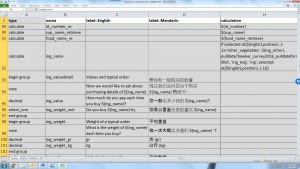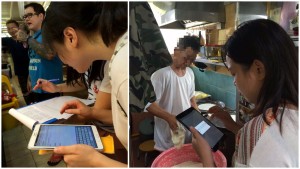Taking a nice hot bowl of prawn noodle has become my ritual every time I return to Singapore. Who doesn’t savor the sweetness of the fresh prawn and the earthy broth brought on by the long simmering of prawn heads and pork bones? I’m sure many people love it, miss it and crave for it when they’re away. However, as we deeply indulge in the sip of prawn broth that often reminds us of our great childhood, we often neglect one question which has become more legitimate and important: “Where does the prawn come from?”
Twenty years ago, food was often locally produced. Our grandparents would get prawns from a nearby shrimp farm, purchase vegetables from their neighbors and even grow their own chickens for eggs. Today, the food chain has become more complex. Salmon, for example, is farmed in Norway, imported and processed by food importers, and distributed by wholesalers and retailers before it arrives at our restaurants and our homes. On the one hand, the globalization and specialization of the food chain gives us more choices and brings down the price. On the other hand, it makes it more challenging to trace food contaminants and identify the sources of foodborne illnesses, which has been on the rise. In Singapore, for instance, the incidences of gastrointestinal diseases reported by polyclinics has risen by 13% between 2010 and 2012(1). In emerging economies like China, public fear of unsafe food has tripled from 2008 to 2015, partly due to the failure of its national system to capture its highly intricate network of food distribution(2). Intrigued by the complexity of the food chain, my colleagues and I recently conducted a survey to understand the supply chain of the hawker food in Singapore. Through the survey, we would like to answer some questions:
(1) How many providers and middlemen are there in the food network? The more we have, the more difficult it is to trace food contaminants during outbreaks.
(2) How stable is the food network? In other words, how elastic is the choice of suppliers when there are price fluctuations, new regulations or outbreaks of foodborne illnesses? If it is elastic, the network is more likely to change over time, making it difficult to monitor food contaminants and maintain foodborne diseases surveillance.
(3) Are there any dominant suppliers in the food network? Dominants suppliers are those who connect to a number of upstream or downstream distributors or have a large flow of products in values or volumes. Understanding who are the key suppliers is important in the context of food safety, because of their capacity to distribute products to a large number of end consumers.
In summer 2015, my colleagues conducted a survey pilot in three hawker centers. You could read her blog post here. This year, from May to August 2016, we completed over 200 interviews with stall owners in nine hawker centers. In the next few months, we will be cleaning and analyzing data, so do expect another post on the results of our survey. Meanwhile, I would like to share with you some fun and challenges I had. This isn’t my first time conducting a survey, but it is my first time developing a tablet-based survey, working with students and interviewing hawkers, from which I draw tremendous joy and inspirations.
My first challenge was to develop a tablet-based questionnaire using Open Data Kit. In order to that, I first built a survey question in an Excel file using XLSForm syntax. Afterwards, the excel file will be imported to Ona, a tool to store and manage survey data. After excel file is imported, it will be converted into xml format, which will be read by the Open Data Kit (ODK). ODK is installed in each of the tablet and it translates the xml file into survey questions shown in the tablet screen. Using tablet-based questionnaire offers a great deal of benefits: the data entry step can be skipped entirely, input data can be restricted and validated, and information from baseline surveys can be incorporated into follow-up surveys. However, it lacks the ability to display tables or other kinds of hierarchy and relationships. In other words, it can only display a question by question. This linearity means that it becomes less efficient and difficult to capture relational data, which is the case of our survey. Therefore, one should carefully weight the pros and cons when deciding whether to tablet-based questionnaire.

Like learning other syntax, learning how to use XLSForm fluently is tedious, i.e. avoiding spelling error or not missing a comma, else it could easily cost you a few hours of troubleshooting, as it did to me. Nevertheless, the real challenge is to work around the incompatibility between XLSForm and ODK platform. ODK platform is an open-source (yes, it’s free!), which means that some commands in XLSForm are not fully supported by ODK platform. This is where I had an endless joy of googling about ODK codes, joining the vibrant online community of ODK users and getting updates about which work and which doesn’t work. The real fun began when I started to build a double loop, or loop-within-loop, to capture the relational data on hawkers, suppliers and ingredients. The whole process was frustrating yet highly rewarding. Fortunately I received so much help from my colleagues and friends who had prior experience in XLSForm and other programing languages. Without them, I would not be able to build the form I needed. I hope that this experience will prepare me to learn other programming languages such as R, STATA and VBA.
My second source of joy and fun was the group of students I had the pleasure to work with. In my previous surveys, I either collected data on my own or engaged a survey firm. Fortunately, in this project I had an opportunity to work with a wonderful team of eight students from the National University of Singapore. I enjoyed learning about the strengths and weaknesses of each individual and how their personalities complement each other. Some are smart, meticulous and disciplined while some others are more relaxed and yet delightful and good-humored. Nevertheless, they all loved the project and enjoyed interactions with hawkers, despite occasions of busy, unfriendly hawkers and high refusal rate. Their sheer sense of humor and joy lightened my days and stories of their interests, dreams and challenges also inspired me a great deal. I was so delighted that some of them were considering public health as their future career. Whether they will pursue public health or not, I know they will become great people.

The last part of the data collection which I really miss is the hawkers and their endless kindness. Many people went a long way to help me and the students. Some used their reputation to introduce us to other stall owners in the hawker centers. Some participated in our survey even though they were so busy they didn’t have time for lunch. Some treated us with their best dishes, and a few insisted to treat us the second time despite us politely declining. Not to mention the stories of their life and dishes, which I always greatly enjoyed. Hawkers aren’t people who earn a great salary despite their long hours of hard work (and for that reason, many young people aren’t keen to take on hawker businesses), but they are definitely one of the kindest people on earth.
Sometimes this project reminds me why I chose this profession early in my career: the technical challenge, the interaction with people from different walks of life and the meaning behind both the numbers our surveys capture and the stories people share. Now I can’t wait to bring the skills and experience I have learnt so far to my next project on antimicrobial resistance. So stay tuned for my next post!
(1) Singapore Ministry of Health. Communicable Disease Surveillance in Singapore 2011.,” 2011. [Online]. Available: http://www.moh.gov.sg/content/moh_web/home/Publications/Reports/2012/ _communicable_diseasessurveillanceinsingapore2011.html. [Accessed: 18-Mar-2014]
(2) BBC News. Will China’s new food safety rules work? 2015. [Online]. Available: http://www.bbc.com/news/blogs-china-blog-34398412. [Accessed: 29-August-2016]